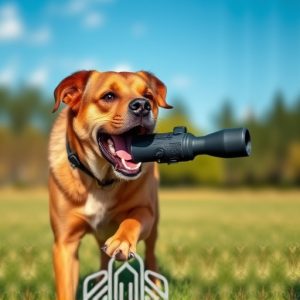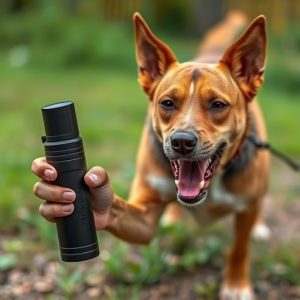Canine Pepper Spray: Effective Deterrent Guide for Distance & Safety
Dog spray, or canine pepper spray, is a non-lethal deterrent that releases capsaicin to temporarily…….
Dog spray, or canine pepper spray, is a non-lethal deterrent that releases capsaicin to temporarily disable aggressive dogs. The key to its success lies in the deployment distance guide of 3-5 meters (10-16 feet). Effective use requires considering factors like spray quality, dog size and behavior, environmental conditions, and technique. A recommended 4-6 meter (13-20 feet) range minimizes cross-contamination while ensuring optimal effectiveness. Legal regulations govern sale, possession, and use, with mandated deployment distances of 4-7 meters (13-23 feet). Training dogs to recognize pepper spray enhances its deterrence power through controlled introductions and rewards for calm behavior.
“Discover the power of canine pepper spray as a safe and effective deterrent in this comprehensive guide. Learn how this non-lethal solution works and understand the crucial factors influencing its deployment distance, ensuring optimal protection. Explore safe use techniques, legal considerations, and training strategies to prepare your dog for unexpected situations. By understanding the dynamics of canine pepper spray deployment distance, you’ll be equipped with a valuable tool to enhance your pet’s safety.”
- Understanding Dog Spray: What It Is and How It Works
- Factors Influencing Canine Pepper Spray Deployment Distance
- Safe Use and Application Techniques for Optimal Deterrence
- Legal Considerations and Regulations Surrounding Dog Spray
- Effective Strategies for Training Dogs to Respond to Pepper Spray
Understanding Dog Spray: What It Is and How It Works
Dog spray, also known as canine pepper spray, is a non-lethal deterrent designed to temporarily incapacitate and deter aggressive dogs. It’s a safe alternative to traditional pepper spray used by humans, formulated specifically for use on animals. When deployed, the spray releases capsaicin, the same compound that gives chili peppers their heat. This irritates the dog’s eyes, nose, and respiratory system, causing them to temporarily become distracted and less aggressive.
The effectiveness of dog spray lies in its deployment distance guide, typically ranging from 3 to 5 meters (10-16 feet). This allows users to apply the spray at a safe distance, minimizing the risk of injury to both the user and the dog. The Canine Pepper Spray Deployment Distance Guide is crucial for ensuring that the spray reaches the target without putting anyone in harm’s way.
Factors Influencing Canine Pepper Spray Deployment Distance
When considering canine pepper spray as a deterrent, understanding its deployment distance is crucial for effective use and safety. Several factors significantly influence how far the spray reaches and remains effective. One key factor is the quality and concentration of the pepper spray itself—higher concentrations generally offer a longer range. The size and movement of the target dog also play a role; larger dogs or those moving quickly may require closer application to ensure the spray makes contact.
Environment conditions like wind, temperature, and humidity can dramatically affect the spray’s trajectory and persistence. A windy day might cause the spray to disperse more quickly, reducing its effective range. Humid conditions can also impact the spray’s performance by affecting its evaporation rate. Additionally, the distance at which the spray is deployed should consider the dog’s behavior and training—a startle effect may be sufficient for a well-trained dog closer by, while a stronger blast might be needed to deter an untrained or aggressive dog at a greater distance.
Safe Use and Application Techniques for Optimal Deterrence
When using canine pepper spray, safety is paramount. It’s crucial to follow strict guidelines for application to ensure both the effectiveness of the deterrent and the well-being of everyone involved. This includes understanding the deployment distance; generally, a safe range for spraying is between 4 to 6 meters (13 to 20 feet). Aiming directly at the assailant’s face or eyes offers maximum impact while minimizing cross-contamination.
For optimal deterrence, consistent and measured application is key. Users should aim for a fine mist, avoiding heavy sprays that can blow back. Training is essential; practice proper technique in controlled environments to build confidence and ensure the spray is deployed accurately under stress. Regular maintenance of the device and understanding its expiration date are also vital aspects of safe use.
Legal Considerations and Regulations Surrounding Dog Spray
The legal landscape surrounding canine pepper spray, or dog spray, varies across jurisdictions, reflecting differing societal views on animal control and self-defense. In many regions, dog spray is regulated under broader guidelines for pepper spray or chemical deterrents, with specific rules governing its sale, possession, and use. These regulations often differentiate between personal protection sprays designed for human use and those marketed towards dogs, which typically have a shorter range and lower concentration to minimize harm to animals.
Key considerations include age restrictions, requirement for permits or prescriptions, and permitted use cases. For instance, in some areas, dog spray is only legal for specific purposes like controlling aggressive dogs or protecting individuals during walks. Deployment distance guides, such as the recommended 4-7 meter (13-23 feet) range for canine pepper spray, are also mandated by law to ensure responsible and safe usage. Adhering to these regulations is crucial for both dog owners and advocates to protect themselves legally while promoting ethical animal management practices.
Effective Strategies for Training Dogs to Respond to Pepper Spray
Training dogs to recognize and respond appropriately to pepper spray is a crucial step in ensuring its effectiveness as a deterrent. Start by introducing the concept gradually, using a safe, controlled environment to simulate pepper spray deployment. This can involve using a specialized training spray or even a mild, natural alternative to acclimatize your dog to the sensation of irritation.
Encourage positive associations by rewarding calm behavior with treats and praise. It’s essential to practice at varying distances as per the Canine Pepper Spray Deployment Distance Guide, ensuring your dog understands that the response is required regardless of proximity. Consistent training sessions will help reinforce the message, making your dog a more responsive and reliable deterrent partner.
Dog spray, or canine pepper spray, has established itself as a safe and effective deterrent when used appropriately. Understanding its deployment distance, safe application techniques, legal considerations, and training strategies is key to maximizing its deterrence potential. By following the guidelines outlined in this Canine Pepper Spray Deployment Distance Guide, pet owners and professionals can ensure they have a powerful tool at their disposal for protecting against aggressive canine encounters while adhering to legal boundaries.


